|
|
|
Sort Order |
|
|
|
Items / Page
|
|
|
|
|
|
|
| Srl | Item |
| 1 |
ID:
118871
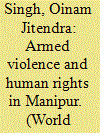

|
|
|
| 2 |
ID:
092121
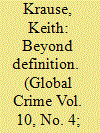

|
|
|
|
|
| Publication |
2009.
|
| Summary/Abstract |
While conceptualising violence - in either minimalist or comprehensive understandings - has posed significant problems for scholars, the problem of measuring or quantifying it has been equally challenging for both researchers and policy makers. This article examines the best available current evidence on the 'global burden of armed violence' and highlights what we know and do not know about the scope, scale, and distribution of different forms of violence worldwide, especially what policy makers have called 'armed violence' (the minimalist conception). It also examines the definitional and conceptual constraints that challenge any attempt to develop cross-national and cross-cultural comparisons, and the limitations of existing data, and brings the empirical evidence to bear on the conceptual debates that animate this volume. Finally, it raises some questions concerning the way in which the different forms that violence takes may (or may not) be linked, and the issues this raises for future 'global' comparisons.
|
|
|
|
|
|
|
|
|
|
|
|
|
|
|
|
| 3 |
ID:
125241
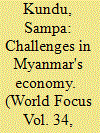

|
|
|
|
|
| Publication |
2013.
|
| Summary/Abstract |
The above quotation decodes that President Thein Sein logically identified three most serious concerns of contemporary Myanmar - legacy of the long army rule, unremitting armed violence and economic stagnation - in his speech in front of the leading business and political figures of the world. In fact, one can make these three causes responsible for Myanmar's transformation from one of the brightest economies to an embarrassment for Southeast Asia, in the first six decades of independence.
|
|
|
|
|
|
|
|
|
|
|
|
|
|
|
|
| 4 |
ID:
129394
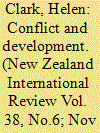

|
|
|
| 5 |
ID:
151615
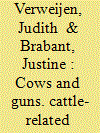

|
|
|
|
|
| Summary/Abstract |
This paper analyses the role of cattle in the entwined dynamics of conflict and violence in the Fizi and Itombwe region of South Kivu province, in the eastern Democratic Republic of the Congo. On the one hand, agropastoral conflict intensifies armed mobilisation, allowing armed groups to draw upon particular conflict narratives that generate popular and elite support. It also creates incentives for armed actors to engage in cattle-looting, or the defence against it, for both symbolic and material reasons. On the other hand, the presence of armed forces and the use of violence profoundly shape agropastoral conflicts. Importantly, they change the perceived stakes of these conflicts, and hamper their resolution. By showing that the relations between cattle-related conflict and armed activity are indirect, complex and mutual, the paper refines both theories on agropastoral conflict and those highlighting the role of local conflicts in fuelling violence in the eastern Congo.
|
|
|
|
|
|
|
|
|
|
|
|
|
|
|
|
| 6 |
ID:
151470
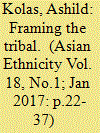

|
|
|
|
|
| Summary/Abstract |
This article examines the framing of ‘ethnic conflict’ in Northeast India, focusing on militant groups and insurgency in the hill areas of Assam and a form of political violence known locally as ‘ethnic clashes’. The article argues that ‘ethnic clashes’ have become an institutionalized form of armed violence in the region, while ‘ethnic rivalry’ is a key diagnostic frame for conflict. As enactments and imaginaries of institutionalized violence, ‘ethnic clashes’ are a product of actors who hold stakes in representing armed political violence as a result of ‘ethnic conflict’ between rivaling tribal communities. The article looks at the representation of causes of conflict as well as the framing of acts of violence as key sites of contestation, and thus as integral aspects of the conflict. This raises questions about the feasibility of scholarly efforts to make sense of specific cases of conflict via generic categories such as the ‘ethnic conflict’.
|
|
|
|
|
|
|
|
|
|
|
|
|
|
|
|
| 7 |
ID:
108964
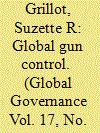

|
|
|
|
|
| Publication |
2011.
|
| Summary/Abstract |
The global spread and misuse of small arms is one of the most alarming and growing security issues of the post-Cold War era. For many reasons, however, controlling the spread of small arms is extremely difficult. Nonetheless, given the serious nature of the small arms issue, numerous states, nongovernmental organizations, and individual activists have sought to address various small arms problems. One of the earliest suggestions that analysts and advocates offered was to develop international norms and standards of behavior that outline the parameters of acceptable small arms activities. Despite the numerous actions that states and NGOs have taken over the past ten years in an effort to combat these problems, corresponding norms are relatively weak or nonexistent. This article seeks to answer why this is the case. It examines why global small arms control norms are largely weak or nonexistent and explains why the prospects for stronger norms are few. Although research on norms in international relations is swelling with studies showing whether, how, and why norms emerge and affect state behavior, few studies focus on cases where norms actually do not emerge or influence action. The primary explanation for weak small arms norms is a competitive normative environment that is facilitated and perpetuated by: (1) competing coalitions that promote opposing norms and ideas and (2) a great-power consensus that works against stronger arms control norms.
|
|
|
|
|
|
|
|
|
|
|
|
|
|
|
|
| 8 |
ID:
106965
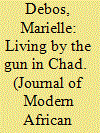

|
|
|
|
|
| Publication |
2011.
|
| Summary/Abstract |
This article explores men in arms' conceptions of armed violence in a country which has been prone to a violent cycle of rebellion and repression. Based on ethnographic research in Chad, it analyses combatants' life trajectories in an unstable political environment and a militarised economy. It moves beyond rebellion towards an analysis of the most mundane patterns of the activities conducted by men in arms, to understand what is at stake beyond times and spaces of war. It argues that armed violence is an ordinary way of expressing contestation, as well as a practical occupation or métier, a French word that indicates a non-institutionalised profession.
|
|
|
|
|
|
|
|
|
|
|
|
|
|
|
|
| 9 |
ID:
151795


|
|
|
| 10 |
ID:
167380
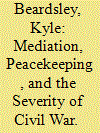

|
|
|
|
|
| Summary/Abstract |
One of the proposed benefits of third-party involvement that has been offered to justify its use is that it helps reduce the severity of conflict. Existing work finding that peacekeeping operations reduce battle-related fatalities considers peacekeeping in isolation from other forms of third-party diplomatic involvement, such as mediation. We argue that mediation has its own effect on patterns of violence. Moreover, we argue that peacekeeping and mediation can have an interactive effect, in which each enhance the violence-reducing potential of the other. Using monthly data on battle-related deaths in African intrastate conflicts, we find that mediation is associated with reduced bloodshed. We also find, consistent with existing work, that a greater number of peacekeepers leads to a reduction in violence. In addition, we find that mediation and peacekeeping efforts reinforce one another, although each type of involvement is able to reduce battlefield fatalities independently.
|
|
|
|
|
|
|
|
|
|
|
|
|
|
|
|
| 11 |
ID:
165164
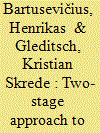

|
|
|
|
|
| Summary/Abstract |
We present a two-stage approach to civil conflict analysis. Unlike conventional approaches that focus only on armed conflict and treat all other cases as “at peace,” we first distinguish cases with and without contested incompatibilities (Stage 1) and then whether or not contested incompatibilities escalate to armed conflict (Stage 2). This allows us to analyze factors that relate to conflict origination (onset of incompatibilities) and factors that predict conflict militarization (onset of armed violence). Using new data on incompatibilities and armed conflict, we replicate and extend three prior studies of violent civil conflict, reformulated as a two-stage process, considering different estimation procedures and potential selection problems. We find that the group-based horizontal political inequalities highlighted in research on violent civil conflict clearly relate to conflict origination but have no clear association with militarization, whereas other features emphasized as shaping the risk of civil war, such as refugee flows and soft state power, predict militarization but not incompatibilities. A two-stage approach to conflict analysis can help advance theories of civil conflict, assess alternative mechanisms through which explanatory variables are thought to influence conflict, and guide new data-collection efforts.
|
|
|
|
|
|
|
|
|
|
|
|
|
|
|
|
| 12 |
ID:
159302
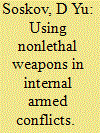

|
|
|
|
|
| Summary/Abstract |
This paper elaborates the notion of internal armed conflict. It shows that the distinctive features of internal armed conflicts imply wide use of nonlethal weapons by state law enforcement agencies. It explains the role of such weapons in putting an end to similar conflicts at various stages in their development.
|
|
|
|
|
|
|
|
|
|
|
|
|
|
|
|
|
|
|
|
|